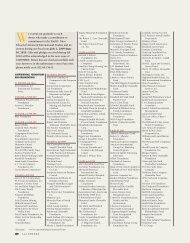Download Current Issue - SAIS
Download Current Issue - SAIS
Download Current Issue - SAIS
Create successful ePaper yourself
Turn your PDF publications into a flip-book with our unique Google optimized e-Paper software.
low-income countries have had few if<br />
any telecommunication links with the<br />
outside world. Markets do not work<br />
well in an information vacuum, and it<br />
creates opportunities for unscrupulous<br />
middlemen to exploit farmers who<br />
have no way to know the prices in other<br />
markets. This has changed rapidly with<br />
the advent of the cellular telephone and<br />
construction of cell towers throughout<br />
many poor countries. Lack of rural electrification<br />
is also a severe impediment<br />
to development of the nonfarm rural<br />
economy—including food processing<br />
to reduce large post-harvest losses and<br />
delivery of rural health care and educational<br />
services.<br />
Investments in Public Goods<br />
Public investments in agricultural<br />
research have been an important source<br />
of the large differences in crop yields<br />
per hectare observed across regions.<br />
Agricultural technologies tend to be<br />
location-specific. The tools of agricultural<br />
research are highly mobile, but<br />
plant varieties need to be optimized for<br />
each local agroecosystem through adaptive<br />
agricultural research.<br />
With global climate change, all<br />
agroecosystems will be shifting. Larger<br />
investments in adaptive research will be<br />
required to sustain present productivity<br />
levels—not to mention that the average<br />
productivity of land already in use will<br />
need to be doubled.<br />
Public investments in agricultural<br />
research and technology transfer played<br />
a large role in the agricultural development<br />
of the presently high-income<br />
countries that enjoy strong agricultural<br />
productivity levels. Research results<br />
were made freely available, and publicly<br />
supported farmer education programs<br />
were created to encourage their diffusion.<br />
These investments benefited farmers<br />
through higher household incomes<br />
and benefited consumers through<br />
lower-cost food.<br />
The social rates of return on the<br />
public sector’s investments in rural<br />
infrastructure, education, health and<br />
agricultural research are extremely<br />
high. In low-income countries, where,<br />
as noted above, almost three-quarters of<br />
people in extreme poverty and hunger<br />
are in rural areas, the agricultural sec-<br />
tor is contributing less to the national<br />
food supply and to world food security<br />
than is economically efficient and environmentally<br />
sustainable. Nevertheless,<br />
investments in agricultural and rural<br />
development by low-income country<br />
governments, official development<br />
assistance and international development<br />
bank lending declined from the<br />
mid-1980s to negligible levels until a<br />
small turnaround occurred after the<br />
food price spike of 2008.<br />
Moreover, with an eye on keeping<br />
food prices as low as possible for urban<br />
consumers, the governments of many<br />
low-income countries turned the terms<br />
of trade against their farmers through<br />
policy interventions in markets, forcing<br />
them to pay more than the world market<br />
price for their inputs and to receive<br />
less than the world market price for<br />
their output. This reduced the incentive<br />
for farmers to implement productivityenhancing<br />
technologies. In recent<br />
decades, this discrimination against<br />
farmers has been remedied in all parts<br />
of the developing world except Sub-<br />
Saharan Africa and Argentina, where it<br />
continues.<br />
Cutting Hunger in Half<br />
In 2000, the heads of state of more than<br />
200 countries meeting at the United<br />
Nations adopted several Millennium<br />
Development Goals, the first of which<br />
is to cut the incidence of hunger and<br />
poverty in the world by half by 2015.<br />
This goal cannot be achieved unless the<br />
rates are reduced in rural areas, where<br />
the majority of hungry and poor people<br />
reside.<br />
Accomplishing this feat will require<br />
a greatly strengthened commitment to<br />
agricultural and rural development.<br />
With a possible doubling of global<br />
demand for agricultural products in the<br />
first half of the 21st century, the world<br />
needs low-income countries with a history<br />
of underperforming agricultural<br />
sectors to contribute more to their own<br />
and the world’s food supply. Failure to<br />
do so could result in adverse geopolitical<br />
consequences. n<br />
Robert L. Thompson is a visiting scholar<br />
at <strong>SAIS</strong>. He is also a senior fellow at the<br />
Chicago Council on Global Affairs and<br />
a professor emeritus at the University of<br />
Illinois at Urbana-Champaign.<br />
2011–2012 11



